Pickleball Volley Drills to Get Fast Hand at the Net
In the thrilling game of pickleball, where strategy and agility play crucial roles, volleys represent the heart of offensive play. Successfully executing a volley can mean the difference between winning and losing a point, often determining the tempo of the match. When players stand on the kitchen line, focused and poised, they must channel their inner athletes, responding quickly to the onslaught of high-speed shots from opponents.
Becoming proficient at volleying not only enhances one’s skill set but also builds confidence, empowering players to take control of the net. As we delve deep into the realm of pickleball volley drills, it’s time to unlock the secrets that can transform an uneasy beginner into an agile volleying machine, equipped with the necessary tools to dominate any pickleball game.
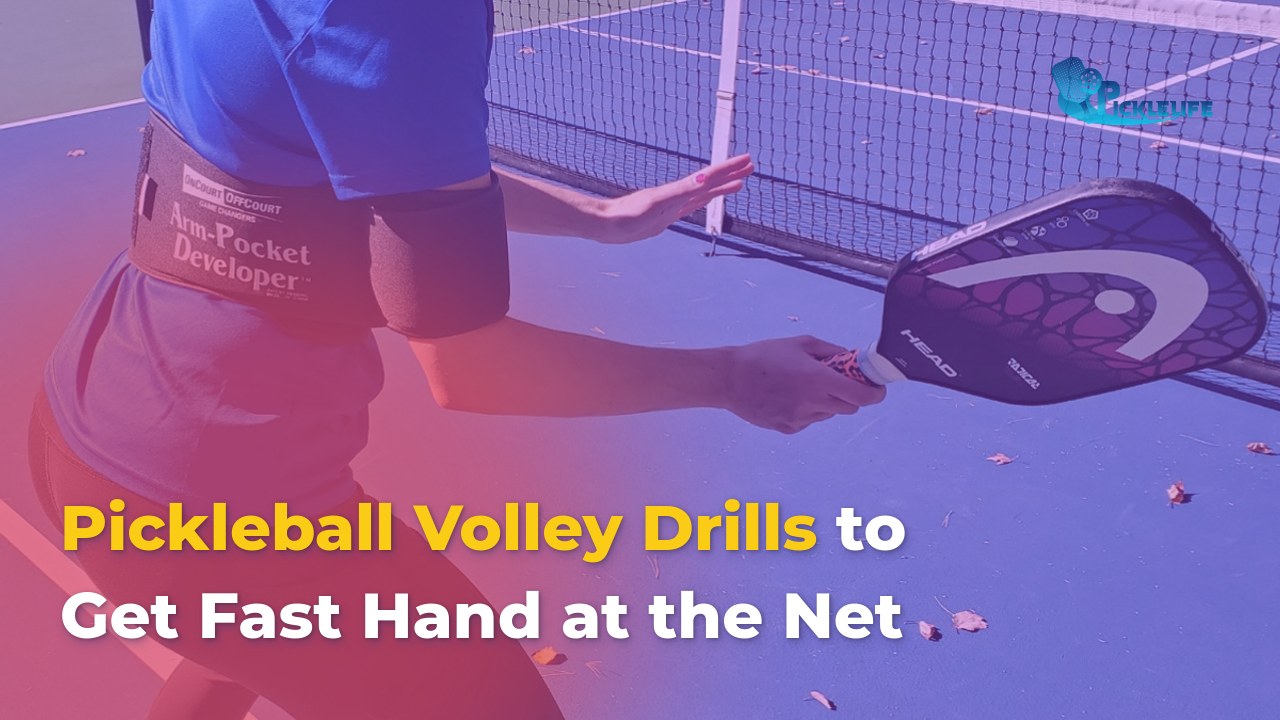
What is a volley?
A volley in pickleball is defined as hitting the ball before it bounces on the court. This definition sets it apart from other techniques like dinks, where players allow the ball to bounce before returning it. The distinction is essential for players looking to sharpen their skills. Mastering the volley enables players to seize control of the game, placing them in a strategic position to dictate play.
Often, one can compare the volley to a dance a rhythmic interplay between two players where timing, anticipation, and precision are everything. Just like a dancer must know their steps before hitting the stage, a pickleball player must be well-versed in volley techniques to star at the net. Becoming adept at volleying also allows players to rely less on their opponents’ mistakes and more on their strategic plays, thus shifting the momentum in their favor.
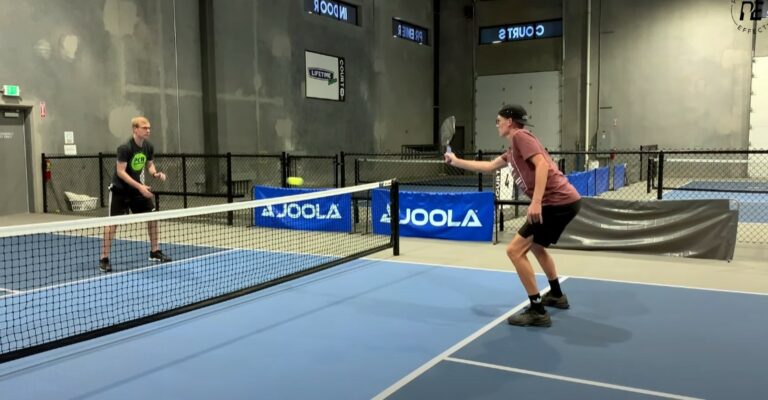
The power of volleying in pickleball
In the world of pickleball, the importance of volleying cannot be overstated. Controlling the net is akin to holding the reins of a powerful horse; the player with voltage at the net can steer the game in their direction. An effective volley is not just about returning the ball; it’s about executing a strategic shot that puts pressure on an opponent. This is an essential aspect of offensive pickleball, where players learn how to maintain their advantage by capitalizing on their opponent’s weaknesses.
Studies have shown that players who practice targeted volley exercises improve not only their shot placements but also their overall game strategy. They learn to anticipate their opponents’ shots and react with speed and precision. Ultimately, a strong volley transforms a player from a casual participant to a competitor who can turn the tide of a match.
Building a solid foundation: The fundamentals
To become a proficient volley player, you must first establish a solid foundation. The fundamentals of volleying are similar to laying the groundwork for a sturdy building; without them, everything may crumble under pressure. Mastering the basics ensures a player’s confidence and performance on the court. This section will explore the essentials that every player must understand before embarking on their journey to volley mastery.
Choosing the right grip
The grip is a player’s connection to the paddle, much like a chef’s relationship with their knife. Choosing the right pickleball grip for volleys is pivotal in executing a successful shot. Generally, players use the continental grip, which provides the flexibility to switch between forehand and backhand shots with ease. The eastern grip is also a common choice, particularly for those looking to add more topspin to their volleys.
Here’s a breakdown of common grips:
| Grip Type | Characteristics | Ideal For |
|---|---|---|
| Continental | Versatile; suitable for both forehand and backhand | Quick reaction shots and volleys |
| Eastern | Adds topspin; great for groundstrokes | Players who want more control and depth |
Finding the right grip comes down to personal preference and playstyle. Players new to the sport may experiment with different grips to find what feels best for them. The key lies in practicing with consistent grip pressure to deliver each volley with the right force and precision.
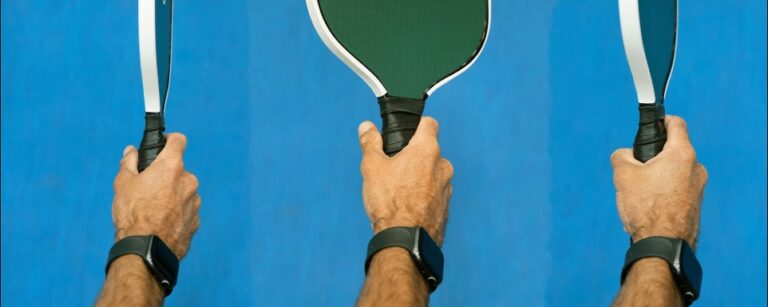
Finding your ready position
A player’s ready stance is akin to a runner waiting for the starting gun to sound poised, balanced, and aware. Maintaining an optimal paddle position for volleying is crucial; the paddle should be held comfortably in front of the body, allowing for quick engagement with the ball. Proper footwork complements the stance, enabling players to shift swiftly in response to their opponent’s shots.
Below is a simple checklist to establish an effective ready position:
- Feet shoulder-width apart for balance.
- Knees slightly bent to allow for quick movements.
- Paddle held in front, angled slightly upward.
- Eyes on the ball, ready to react at any moment.
By mastering the ready position, players can enhance their agility and quickness on the court, setting the stage for effective volleying.
Pickleball volley drills: Mastering the backhand volley
The backhand volley is often viewed as a challenging aspect of the game, yet it holds the potential to become a player’s secret weapon. It’s like wielding a sword in a duel while it requires practice, it empowers those who can master it to strike effectively against opponents. In this section, we will delve into the techniques, common mistakes, and drills that can elevate a player’s backhand volley performance.
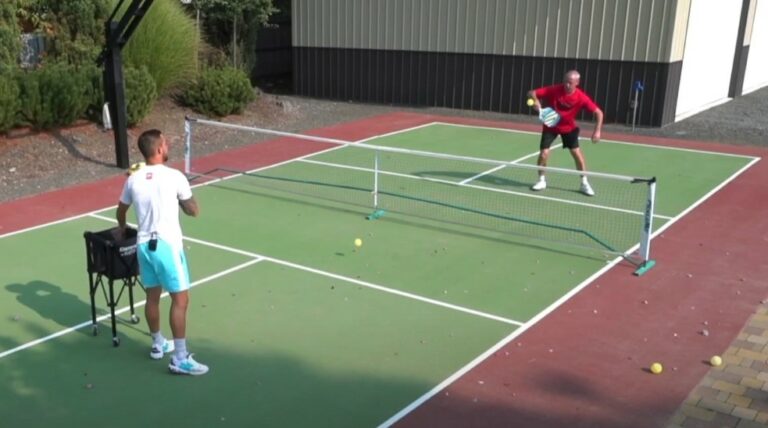
Backhand volley technique: Step-by-step
To execute a successful backhand volley, players should follow a sequence of steps akin to crafting a fine piece of art:
- Grip the paddle: Use the continental grip to maintain flexibility.
- Align your body: Position your non-dominant shoulder toward the net.
- Step forward: As the ball approaches, step with your non-dominant foot.
- Swing smoothly: Use a short and controlled swing, leading with the paddle face.
- Follow through: Complete the motion by directing the paddle toward the target area.
By breaking down the backhand volley into manageable steps, players can develop a better understanding of their technique, ultimately leading to improved accuracy and power.
Common backhand volley errors (and how to fix them)
Even seasoned players are susceptible to errors. The key is to recognize and correct them swiftly. Common backhand volley mistakes include:
- Hitting into the net: Often caused by gripping the paddle too tightly. Solution: Relax your grip for better control.
- Popping the ball up: This happens when players strike the ball too high or fail to follow through. Solution: Maintain a low paddle angle and follow through toward your target.
- Misjudging ball speed: Failing to gauge the ball’s trajectory can lead to late reactions. Solution: Practice with a partner to improve your anticipation skills.
Recognizing and adapting to these errors can significantly enhance a player’s backhand volley, turning it into a reliable asset on the court.
Practice drills for backhand volleys
For those eager to improve their backhand volley skills, integrating specific drills into regular practice can yield transformative results. Here are some beginner-friendly drills:
- Wall Drills: Stand facing a wall at varying distances; practice hitting backhand volleys against the wall, focusing on form and follow-through.
- Partner Feeding: Have a partner gently feed balls to your backhand side, allowing you to practice your volley technique in a controlled setting.
- Game-like Scenarios: Simulate gameplay by having your partner send volleys at varying speeds and angles, pushing you to react and adapt accordingly.
Incorporating these drills not only refines skills but also builds confidence in executing backhand volleys during real matches.
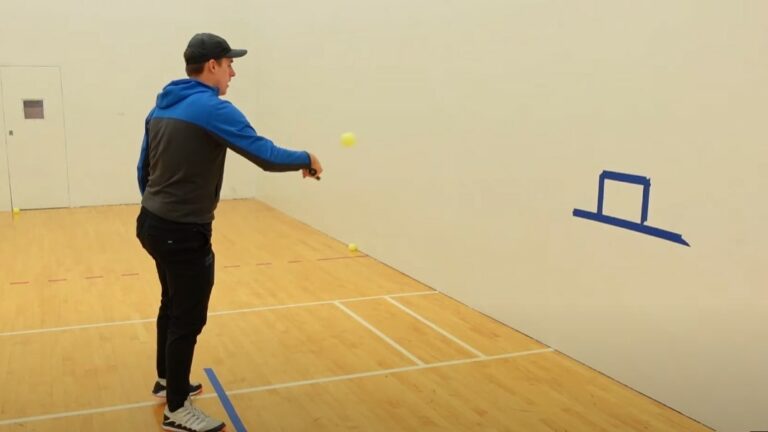
Conquering the forehand volley: Creating space and power
Transitioning from an effective backhand to a forehand volley can significantly shift the dynamics of a match. The forehand is often seen as the “go-to” shot for many players and can be instrumental in creating power and placing the ball strategically. Understanding the technique and practicing consistently can lead to the development of a formidable forehand volley.
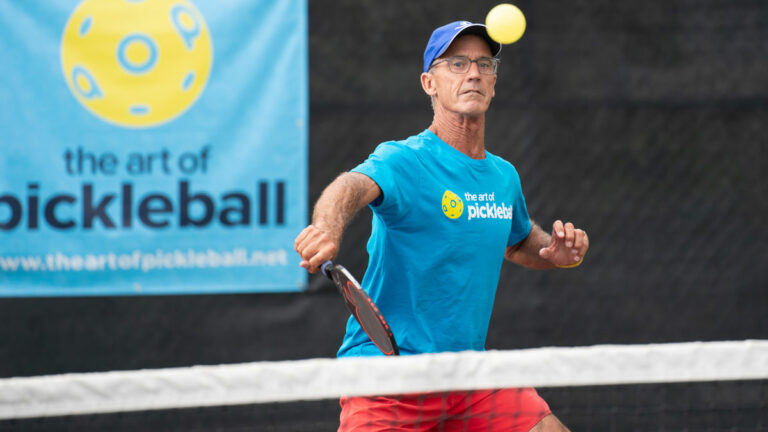
Forehand volley technique: Key points
Mastering the forehand volley requires attention to detail. Key aspects to focus on include:
- Grip Mechanics: Use the continental or eastern grip, depending on your comfort with topspin.
- Body Positioning: Turn your body sideways, positioning your dominant shoulder toward the net.
- Weight Transfer: Shift your weight from your back foot to your front foot as you strike the ball.
- Follow Through: Ensure a clean follow-through in the direction of your target.
Once players internalize these key points, they will notice increased power and placement throughout their volleys.
Avoiding the “jam”: Forehand volley challenges
One frequent challenge while executing a forehand volley is getting jammed when the incoming ball is too close to the player’s body. This can create confusion and often results in weak shots or misses. Players can sidestep this issue by:
- Creating Space: Taking an extra step back or to the side can provide the necessary room to swing confidently.
- Using Angles: Rather than trying to square up directly to the ball, players can angle their paddle to tap the ball precisely without losing power.
By tackling this challenge head-on, players can shield themselves from the frustration that comes with ineffective volleys.
Practice drills for forehand volleys
Implementing focused practice drills can help sharpen forehand volley skills. Here are some drills to get started:
- Target Practice: Have a partner stand across from you and target specific areas on the court while practicing forehand volleys; this enhances precision.
- Position Play: Alternate between practicing volleys from settled positions and while on the run, replicating the unpredictability of match play.
- Reaction Drills: Set up a series of fast feeds from a partner to train rapid reactions for forehand volleys, honing your speed and agility under pressure.
Regularly practicing these drills ensures the development of a powerful and reliable forehand volley that can make a significant impact during actual competition.
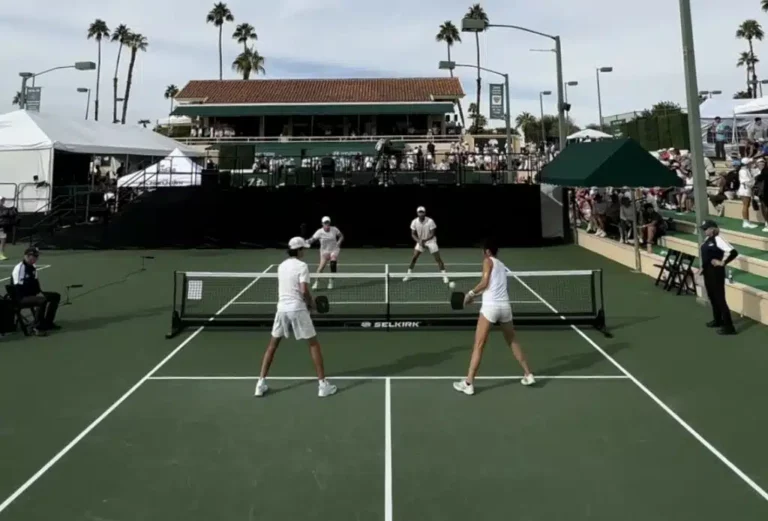
Develop soft hands and lightning-fast reactions
Having soft hands and quick reactions is integral to a player’s ability to volley effectively. The right balance of power and touch can lead to a game that flows gracefully, akin to a beautiful symphony where teamwork and strategy harmonize flawlessly.
The importance of “touch”
In pickleball, touch refers to a player’s ability to feel the ball and respond appropriately, absorbing its speed without losing control. Players with soft hands can soften their grip at critical moments, allowing them to direct volleys with finesse. This skill is paramount when dealing with fast-paced shots, as it prevents over-hitting and keeps the ball within the court boundaries.
Through practice and experimentation, players can cultivate their touch, learning how to adjust their paddle angle according to the ball’s speed and spin. Understanding the concept of touch can earn a player a wealth of advantages on the court, facilitating smoother rallies and enhancing overall performance.
Drills for soft hands and quick reactions
Developing effective touch and quick reactions can be achieved through specific drills designed to improve these attributes:
- Bump and Volley: In pairs, players take turns gently bumping the ball to one another, focusing on absorbing the momentum and controlling placement.
- Quick Feed Volleys: Have a partner feed you balls at varying speeds. The emphasis should be on reacting quickly and maintaining a soft grip as you return the shot.
- Ghost Volleys: Practice your volley technique without the ball by mimicking the motion in the air, concentrating on maintaining a relaxed grip and fluid movements.
These tailored exercises foster the necessary skills to build a refined touch, ensuring that players can control their volleys with precision and finesse throughout their matches.
Move like a pro: Volleying on the run
Mastering the art of volleying is more than just static practice; it involves seamlessly integrating movement into your game. Much like the chicken dance a seemingly effortless yet coordinated display of artistry successfully volleying while moving adds a dynamic element to your play. This section will explore different practices to maximize movement while volleying.
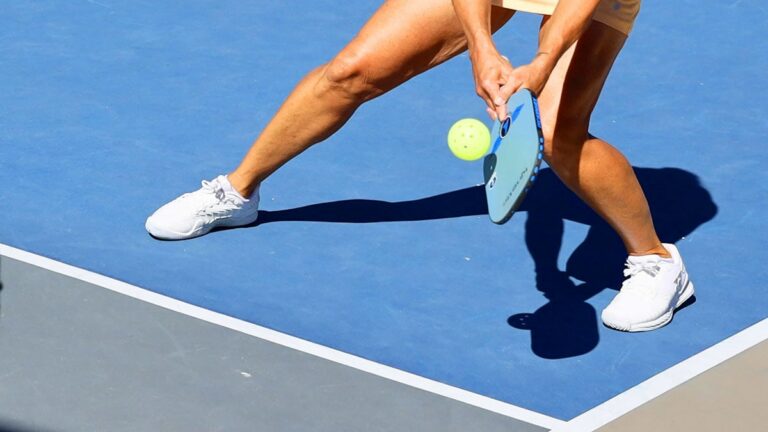
Shuffle volleys: Mastering side-to-side movement
Shuffle volleys are an essential part of volleying on the move. Players need to establish a strong lateral movement that allows for quick repositioning. Optimal footwork can be the determining factor in hitting an effective volley under pressure.
To practice shuffle volleys, players can follow these steps:
- Positioning: Start in a ready stance, with feet shoulder-width apart.
- Shuffle Steps: Use quick lateral steps to shift left or right, while keeping your paddle at the ready.
- Timing: As the ball approaches, lead with your non-dominant foot and follow through with a precise volley.
Integrating shuffle volleys into your routine allows for more fluidity on the court, improving overall agility and reaction time during play.
“Closing In”: Stepping towards the net
Aggressively moving toward the net can change the dynamics of a match, turning defensive plays into offensive opportunities. By practicing closing in volleys, players maintain control and dictate the pace of the game, akin to a lion stalking its prey strategically positioning oneself for a powerful move.
To implement this practice:
- Initial Positioning: Begin near the non-volley zone, ready to react.
- Anticipation: Observe your opponent’s shot and prepare to step closer as the ball approaches.
- Engagement: Take quick but deliberate steps toward the net and execute a confident volley.
By mastering the art of moving in for closing volleys, players boost their competitive edge, fostering a sense of confidence that will shine through in gameplay.
Putting it all together: Game-like volley scenarios
Having a repertoire of skills is essential; however, simulating game-like scenarios can further cultivate a player’s confidence and efficacy on the court. By practicing with a partner or in a team environment, players can develop their tactical awareness and resilience.
Partner drills: Simulating match play
Engaging in partner drills that mimic actual match conditions is a phenomenal way to enhance volley skills. Here are some effective drills:
- Cross-Court Volleys: Position partners diagonally across the net and volley back and forth, focusing on placement and accuracy; this drill sharpens specific targeted areas.
- Timed Rallies: Set a timer for one minute and challenging partners to maintain a volley exchange, fostering stamina and concentration.
- Pressure Play: Simulate crucial points by introducing specific rules that mimic match conditions, such as requiring a specific number of volleys before a winning shot is allowed.
Partner drills not only promote teamwork but also provide an enriching experience that enhances overall tactical awareness during a match.
Handling speed-up volleys: Reacting to pressure
Being prepared to react under pressure is critical in pickleball. Speed-up volleys situations where your opponent sends a fast shot can be daunting, yet they offer a chance to showcase your hard-earned skills.
To prepare for speed-up volleys, consider the following techniques:
- Stay Low: Lower your center of gravity to react quickly and maintain balance.
- Quick Paddle Movements: Develop the habit of positioning your paddle correctly to intercept fast shots effectively.
- Practice with Intent: Have a partner practice sending high-speed volleys your way, improving your reaction time and poised responses in real-game situations.
Consistent practice under pressure is essential, as it cultivates confidence and adaptability qualities that define exceptional pickleball players.
Safety first: Protect yourself on the court
In the heat of the game, players often overlook essential aspects of safety. Adopting proper precautions ensures every player has an enjoyable experience, much like a chess player safeguarding their king while strategically advancing their pieces.
Calling out “ball”
One of the most crucial elements of pickleball court etiquette is communication. Calling out “ball” alerts teammates and opponents alike of an incoming volley. This simple practice minimizes the risk of collisions and keeps everyone engaged.
Stepping aside when necessary
It’s vital for players to recognize when it’s best to yield to teammates or opponents. Understanding this aspect of court dynamics promotes safety, allowing players to maintain focus on their volleys without distraction or concern for collisions.
By embedding these safety measures into play, players enhance their enjoyment and performance on the court while keeping each other accountable.
Volley mastery checklist: Track your progress
To gauge your growth and development as a volley player, consider using a printable checklist that covers the key elements of successful volleys. A checklist can serve as a visual reminder of your skills and areas to improve. Here are some aspects to include on your checklist:
- Grip Consistency
- Ready Position
- Shot Placement Accuracy
- Reaction Time
- Error Rates (common mistakes)
- Comfort in Different Volley Situations
Utilizing this checklist will empower players, enabling them to self-assess and track their progress as they work towards volley mastery.
Conclusion: From beginner to volley virtuoso
Embarking on the journey to become a proficient pickleball player requires practice, patience, and dedication. The art of volleying is no different; transformation from a beginner to a mastery level takes time. Each practiced drill and each learned technique builds upon the last, culminating in an impressive array of skills poised for any match.
As players progress through their journey, they discover the joy of the game, enhancing their combativeness, confidence, and collaboration with teammates. With the right mindset, commitment, and resources, the path to becoming a volley virtuoso is not just a dream it’s an achievable reality. Players can find further learning resources, including instructional videos, articles, and local clubs, enhancing their skills even further.
So lace up those shoes and grab your paddle; the exciting world of pickleball volleying awaits, and every session on the court presents another opportunity for greatness!
